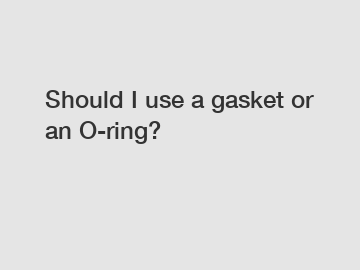Should I use a gasket or an O-ring?
Should I Use a Gasket or an O-ring?
When it comes to sealing applications, the choice between a gasket and an O-ring can often lead to confusion. Both options have their advantages and disadvantages, making it essential to carefully consider the specific requirements of your project. In this article, we will explore the factors that can influence this decision and provide insights into the significance and impact of the chosen sealing solution.
Determining the best option begins with understanding the fundamental differences between gaskets and O-rings. Gaskets are typically flat or partially metallic rings used to create a static seal between two surfaces. They are commonly made from materials like rubber, silicone, or cork, offering versatility in their application. On the other hand, O-rings are circular sealing elements made of elastomers such as nitrile, silicone, or Viton®. Their unique design allows them to maintain a seal in dynamic and static applications, offering exceptional performance in various environments.

The choice between a gasket and an O-ring depends on several key factors. Firstly, the nature of the sealing application is crucial. Gaskets are a suitable option when dealing with large surface areas, irregular shapes, or non-circular connections. Their ability to conform to these challenging geometries makes them an ideal choice. On the other hand, O-rings excel in situations that involve high-pressure conditions, dynamic movements, or tight spaces. Their circular shape ensures uniform sealing pressure, making them highly efficient in preventing leaks.
Another vital consideration is the compatibility of the sealing material with the media being sealed. Gaskets and O-rings are available in various materials, each offering different resistance to chemicals, temperature ranges, and pressure levels. Conducting a thorough analysis of the application's requirements, including the medium's characteristics, is essential to ensure long-term sealing effectiveness.
Furthermore, the cost and ease of installation play a role in the decision-making process. Gaskets are generally more cost-effective than O-rings, especially for larger sealing surfaces. Additionally, gaskets are typically easier to install and replace, providing convenience in maintenance. O-rings, while often more expensive, offer a reliable and long-lasting sealing solution that can ultimately reduce overall maintenance and downtime costs.
In conclusion, the choice between a gasket and an O-ring depends on various factors, including the sealing application's nature, compatibility with the media, and cost-effectiveness. Careful evaluation of these factors will enable you to determine the most suitable solution and ensure optimal sealing performance. Whether you opt for a gasket or an O-ring, partnering with an experienced sealing solutions provider can offer expert guidance and access to high-quality products tailored to meet your specific needs.
If you want to learn more, please visit our website King Seal Oil Seal, difference between o ring and gasket, o ring vs gasket.

Comments